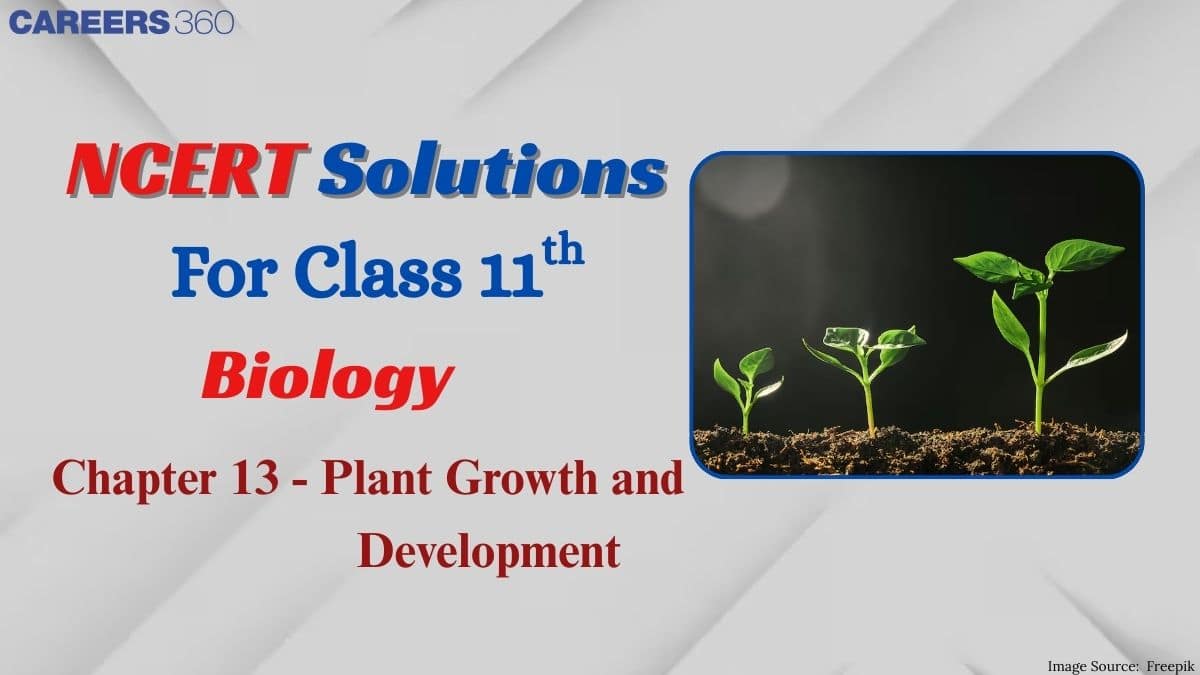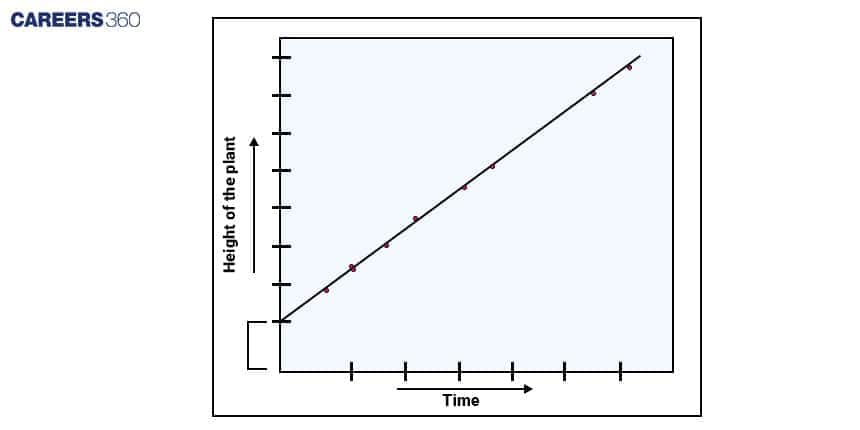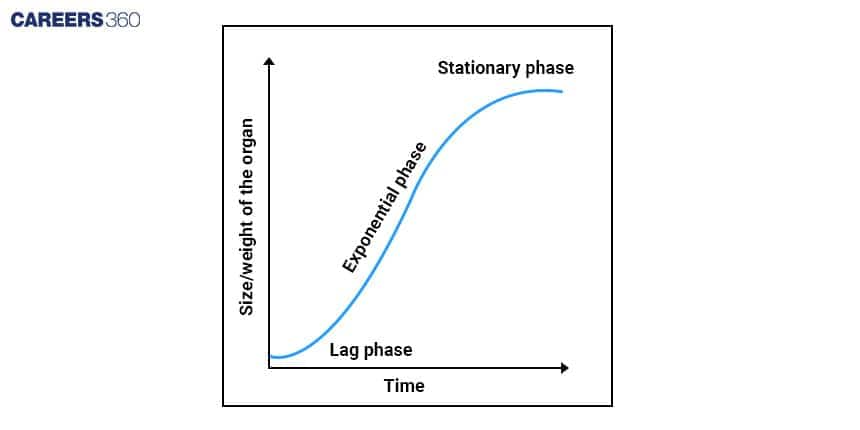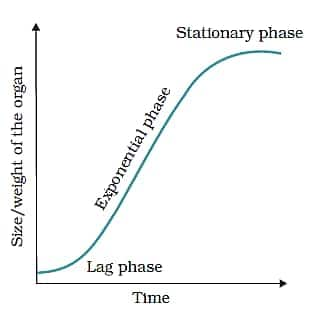NCERT Solutions for Class 11 Biology Chapter 13 - Plant Growth and Development
The NCERT Solutions for Class 11 Biology Chapter 13 - Plant Growth and Development explain how plants grow and respond to their surroundings. It also includes the different stages of plant growth and the internal and external factors, like temperature, light, and nutrients, that affect development. With the help of these answers, students will learn about chemicals called plant hormones. Referring to the NCERT solutions makes it easier for students to perform well in exams.
This Story also Contains
- Download Plant Growth and Development NCERT Solutions PDF
- Class 11 Biology Chapter 13 - Plant Growth and Development Solutions (Exercise Questions)
- Approach to Solve Plant Growth and Development Class 11 Question Answer
- Important Question of NCERT Class 11 Biology Chapter 13
- What Students Learn from Plant Growth and Development NCERT Solutions
- What Extra Should Students Study Beyond the NCERT for NEET?
- NCERT Solutions for Class 11 Biology: Chapter-wise

The Plant Growth and Development class 11 question answer explains topics like seed dormancy, vernalisation, and photoperiodism. It also covers the role of plant growth regulators and how they control processes such as flowering, fruiting, and tropic movements. The Plant Growth and Development chapter is important for school exams as well as for competitive exams like NEET. The NCERT Class 11 Solutions help students understand difficult concepts quickly without any confusion.
Download Plant Growth and Development NCERT Solutions PDF
Students can download the PDF from the link below for offline use. The Class 11 Biology Chapter 13 - Plant Growth and Development question answer PDF can be used offline, making it easy to revise anytime and anywhere.
Also, Read
Class 11 Biology Chapter 13 - Plant Growth and Development Solutions (Exercise Questions)
The solved exercise questions of the chapter Plant Growth and Development are given below. All the solutions are prepared by subject experts, following the NCERT guidelines closely. Students can use the Class 11 Biology Chapter 13 - Plant Growth and Development question answer for strong clarity.
Question 1. Define growth, differentiation, development, dedifferentiation, redifferentiation, determinate growth, meristem, and growth rate.
Solution:
Growth:
It is a permanent, irreversible increase in the size of an organ, one of its components, or even a single cell. Metabolic processes that are taking place as a result of the energy support growth.
Differentiation:
A localized qualitative change in the size, biochemistry, structure, and function of cells, tissues, or organs, such as mesophyll, a leaf, a fibre, a vessel, a trachea, or a sieve tube, is known as differentiation. As a result, both the form and the physiological activity change. It leads to specialization in certain functions.
Development:
Development refers to all the changes an organism experiences over the course of its existence.
Dedifferentiation:
Plants that have lost the ability to divide can regain it under specific circumstances. Dedifferentiation is the term used to describe this phenomenon. Example: meristem formation.
Redifferentiation:
It is referred to as redifferentiation when cells produced by dedifferentiation mature to carry out particular functions but once more lose the ability to divide.
Determinate growth:
Determinate growth is the capacity of a cell, tissue, or organism to grow for a specific amount of time. The majority of plants grow indefinitely; however, some plants reach a certain size before ceasing to expand.
Meristem:
The term "meristem" refers to plant tissue made up of undifferentiated cells (meristematic cells).
Growth rate:
A growth rate is an increase in growth per unit of time.
Question 2. Why is not any one parameter good enough to demonstrate growth throughout the life of a flowering plant?
Solution:
An increase in protoplasm production leads to growth. The parameters used to measure protoplasmic growth include changes in height, weight, number of cells, fresh tissue sample, length, area, volume, etc. As a result, it is challenging to identify a single growth parameter that characterizes a flowering plant's development over its lifetime.
Question 3. Describe briefly.
(a) Arithmetic growth
(b) Geometric growth
(c) Sigmoid growth curve
(d) Absolute and relative growth rates
Solution:
(a) Arithmetic growth
Only one daughter cell divides during arithmetic growth, while the other differentiates and matures. A root extending at a constant rate is the most basic illustration of arithmetic growth.

It can be mathematically expressed as:
$L_t = L_0 + r t$
Where:
$L_t$ = length at time t
$L_0$ = length at time zero
r = growth rate or elongation per unit time
(b) Geometric growth
The initial phase of geometric growth is slow (lag phase), and the subsequent exponential or logarithmic phase sees a rapid increase. Here, both of the progeny cells that result from mitotic cell division are still able to divide. Due to the insufficient nutrient supply, the growth slows down and enters a stationary phase. In geometric growth, the number grows in a multiplicative pattern.

If we plot the growth parameter against time for geometric growth, we obtain a typical sigmoid or S-curve.
Exponential growth can be expressed as:
$W_1 = W_0 e^{r t}$
Where:
$W_1$ = final size
$W_0$ = initial size of the period
r = growth rate
t = time of growth
e = base of natural logarithms
Here, r stands for relative growth and the efficiency index, which measures how well plants can produce new plant materials. The initial size $W_0$ determines the final size $W_1$.
(c) Sigmoid growth curve
Plotting growth against time results in an S-shaped graph that has four main parts: a slow lag phase, an exponential phase or rapid phase, a stage of diminishing growth, and a stationary phase.

(d) Absolute and relative growth rates
The net growth per unit of time is known as the absolute growth rate. The growth rate per unit of time per unit of initial growth is known as the relative growth rate.
Question 4. List five main groups of natural plant growth regulators. Write a note on the discovery, physiological functions and agricultural/horticultural applications of any one of them.
Solution:
Plant growth regulators are the intercellular intrinsic factors (chemical substances) that are responsible for the growth and development of plants.
The following are the top five categories of natural plant growth regulators (PGR):
Gibberellins
Cytokinins
Abscisic acid
Ethylene
These PGRs are synthesized in various plant parts and regulate various developmental and differentiation processes that occur throughout a plant's life cycle.
Gibberellins
Discovery:
One of the first gibberellins to be found, designated as GA1, GA2, and GA3, is gibberellic acid, which is acidic.
More than 100 gibberellins have been identified in a variety of different sources, including fungi and other higher plants.
Physiological functions:
Plants respond physiologically to gibberellins in a variety of ways.
They have the ability to increase the length of the axis, which can result in an increase in the length of grape stalks.
Fruits like apples elongate and acquire a better shape as a result of their presence.
They are in charge of putting off the senescence process.
Agricultural/horticultural applications:
The fruits can be left on the tree for longer to increase the market period because the senescence process is delayed.
Gibberellic acid, or GA3, is a substance that is used to accelerate the malting procedure in the brewing industry.
By spraying the sugarcane crop with gibberellins, which lengthen the stem and increase yield by up to 20 tonnes per acre because sugarcane stems store carbohydrates as sugar, the crop is able to store more carbohydrates as sugar.
Spraying GAs on young conifers can shorten their maturation period and promote early seed production.
Additionally, it encourages the bolting process in plants like cabbage and beets. The elongation of the internode that occurs just before flowering is known as bolting.
Question 5. Why is abscisic acid also known as a stress hormone?
Solution:
Abscisic acid is responsible for stimulating the closure of stomata in the epidermis and raising the tolerance of plants to different types of stresses. This is why it is also known as the stress hormone. In order to ensure that seeds germinate under favourable conditions, abscisic acid is in charge of promoting seed dormancy. This makes it easier for seeds to withstand desiccation and induces dormancy in plants near the end of the growing season, which encourages the abscission of fruits, leaves, and flowers.
Question 6. ‘Both growth and differentiation in higher plants are open.’ Comment.
Solution:
Due to the presence of meristems at specific locations of their bodies, higher plants have the ability to retain the capacity to have indefinite growth throughout their life span. Because of these meristems, the cells have the ability to divide and grow on their own. This explains why the growth in higher plants is open. Following several rounds of cell division, some of these cells go through differentiation. Therefore, differentiation is also open.
Question 7. ‘Both a short-day plant and a long-day plant can produce flowers simultaneously in a given place.’ Explain.
Solution:
In a few plants, flowering depends on the relative durations of light and dark periods. Under the condition that they receive enough photoperiod, both long-day and short-day plants can bloom in the same location.
Question 8. Which one of the plant growth regulators would you use if you were asked to:
(a) induce rooting in a twig.
(b) quickly ripen a fruit.
(c) delay leaf senescence.
(d) induce growth in axillary buds.
(e) ‘bolt’ a rosette plant.
(f) induce immediate stomatal closure in leaves.
Solution:
The plant growth regulators for the related events are listed below:
(a) Induce rooting in a twig. – Auxins
(b) Quickly ripen a fruit. – Ethylene
(c) Delay leaf senescence. – Cytokinins
(d) Induce growth in axillary buds. – Cytokinins
(e) ‘Bolt’ a rosette plant. – Gibberellins
(f) Induce immediate stomatal closure in leaves. – Abscisic acid
Question 9. Would a defoliated plant respond to the photoperiodic cycle? Why?
Solution:
No, a defoliated plant will not respond to the photoperiodic cycle. This is due to the fact that the leaves serve as the sites where dark or light duration is perceived. Therefore, plants would not respond to light if leaves were not present.
Question 10. What would be expected to happen if:
(a) GA3 is applied to rice seedlings.
(b) dividing cells stop differentiating.
(c) a rotten fruit gets mixed with unripe fruits.
(d) you forget to add cytokinin to the culture medium.
Solution:
(a) If GA3 is applied to rice seedlings:
The rice seedlings will show internode elongation, and hence, an increase in height will be observed.
(b) If dividing cells stop differentiating:
The various plant parts, including the stem and leaves, will not form if the dividing cells stop differentiating.
(c) If rotten fruit gets mixed with unripe fruit:
When unripe fruits are combined with rotten fruits, the unripe fruits ripen more quickly due to the ethylene produced by the rotten fruits, which is a plant growth regulator.
(d) If you forget to add cytokinin to the culture medium:
The processes of cell division, differentiation, and growth will be muted and slowed down if cytokinin is not added to the culture medium.
NCERT Solutions for Class 11: Subject-wise
Approach to Solve Plant Growth and Development Class 11 Question Answer
To solve Plant Growth and Development questions efficiently, students can follow the steps given below:
Understand key concepts like growth phases and plant hormones. Underline words like development, growth, and meristem.
Revise the functions of auxins, gibberellins, cytokinins, ethylene, and ABA. The functions of phytohormones are explained in the Class 11 Biology Chapter 13 - Plant Growth and Development question answer.
Outline the seed germination and growth stages of a plant, and learn the steps in correct order.
Go through the Class 11 Biology Chapter 13 - Plant Growth and Development Solutions for revision.
- Practice the previous year's question papers and refer to the NCERT Solutions Class 11 Biology before the exam.
Check the NCERT Books and NCERT Syllabus here:
Important Question of NCERT Class 11 Biology Chapter 13
Given below is a key question that will improve the students' understanding of the topic. To score well on the exam, it is important to do regular practice of different forms of questions. All questions are given in the NCERT Solutions for Class 11 Biology Chapter 13 - Plant Growth and Development.
Question: Growth can be measured in various ways. Which of these can be used as parameters to measure growth?
Options:
1. Increase in cell number
2. Increase in cell size
3. Increase in length and weight
4. All the above
Answer: The correct answer is option 4) All the above
Explanation: Plants can continue to develop for the duration of their lives. This is because specific parts of their bodies contain meristems, which have the capacity to divide and reproduce themselves. The open form of growth refers to the process by which the meristem's activity continuously adds new cells to the plant body. The growth can be in lateral or apex regions and can cause an enlargement in height or weight; all of these changes are collectively termed growth.
What Students Learn from Plant Growth and Development NCERT Solutions
Plants go through various stages as they grow, from seed germination to maturity. Students learn some of the interesting facts and topics about plants by going through these solutions.
Students understand how hormones like auxins, gibberellins, cytokinins, and abscisic acid regulate growth and development.
The Plant Growth and Development class 11 question answer explains processes like photoperiodism and vernalisation that control flowering in plants.
They learn seed dormancy, germination, and the factors that influence these processes.
Using Plant Growth and Development NCERT Solutions, students can study the phases of plant growth, such as cell division, elongation, and differentiation.
Students explore how plant development is affected by both internal factors and external factors.
What Extra Should Students Study Beyond the NCERT for NEET?
Here is a table for all the important topics from the chapter. These topics are highly useful for solving advanced questions in NEET. Students can also revise the NCERT Solutions for Class 11 Biology Chapter 13 - Plant Growth and Development for a better understanding.
Topics | NCERT | NEET |
✅ | ✅ | |
✅ | ✅ | |
✅ | ✅ | |
✅ | ✅ | |
✅ | ✅ | |
✅ | ✅ | |
✅ | ✅ | |
✅ | ✅ | |
✅ | ✅ | |
✅ | ✅ | |
✅ | ✅ | |
✅ | ✅ | |
✅ | ✅ | |
✅ | ✅ | |
✅ | ✅ | |
✅ | ✅ | |
✅ | ✅ | |
✅ | ✅ | |
✅ | ✅ | |
✅ | ✅ |
NCERT Solutions for Class 11 Biology: Chapter-wise
NCERT solutions for all chapters are given below:-
Frequently Asked Questions (FAQs)
Auxins, gibberellins, and cytokinins are plant hormones that play important roles in growth and development. Auxins promote cell elongation and root formation, gibberellins help in stem elongation and seed germination, while cytokinins promote cell division and shoot formation..
Secondary growth is important for plants, particularly woody ones, as it increases girth, providing structural support and enabling the transport of water and nutrients to support a larger number of leaves.
According to the NCERT Solutions for Class 11 Biology Chapter 13 Plant Growth and Development, plant growth occurs in three main phases: meristematic, elongation, and maturation.
Plant hormones, also known as phytohormones, are chemical messengers that regulate plant growth and development by influencing processes like cell division, elongation, and differentiation, as well as responses to environmental cues.
Abscisic acid is a plant hormone. It is also called a stress hormone because it shows different responses to stress conditions. It leads to seed dormancy and ensures seed germination only when favourable conditions return. It also causes the closing of stomata when plants don’t get enough water.
Popular Questions
Courses After 12th
Applications for Admissions are open.
This ebook serves as a valuable study guide for NEET 2025 exam.
NEET Previous 10 Year Questions
Get nowThis e-book offers NEET PYQ and serves as an indispensable NEET study material.
JEE Main Important Physics formulas
Get nowAs per latest syllabus. Physics formulas, equations, & laws of class 11 & 12th chapters
JEE Main Important Chemistry formulas
Get nowAs per latest syllabus. Chemistry formulas, equations, & laws of class 11 & 12th chapters
JEE Main high scoring chapters and topics
Get nowAs per latest 2024 syllabus. Study 40% syllabus and score upto 100% marks in JEE
JEE Main Important Mathematics Formulas
Get nowAs per latest syllabus. Maths formulas, equations, & theorems of class 11 & 12th chapters
